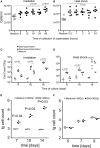Inosine Released from Dying or Dead Cells Stimulates Cell Proliferation via Adenosine Receptors
- PMID: 28496447
- PMCID: PMC5406388
- DOI: 10.3389/fimmu.2017.00504
Inosine Released from Dying or Dead Cells Stimulates Cell Proliferation via Adenosine Receptors
Abstract
Introduction: Many antitumor therapies induce apoptotic cell death in order to cause tumor regression. Paradoxically, apoptotic cells are also known to promote wound healing, cell proliferation, and tumor cell repopulation in multicellular organisms. We aimed to characterize the nature of the regenerative signals concentrated in the micromilieu of dead and dying cells.
Methods: Cultures of viable melanoma B16F10 cells, mouse fibroblasts, and primary human fibroblast-like synoviocytes (FLS) in the presence of dead and dying cells, their supernatants (SNs), or purified agonists and antagonists were used to evaluate the stimulation of proliferation. Viable cell quantification was performed by either flow cytometry of harvested cells or by crystal violet staining of adherent cells. High-performance liquid chromatography and liquid chromatography coupled with mass spectrometry of cell SNs were deployed to identify the nature of growth-promoting factors. Coimplantation of living cells in the presence of SNs collected from dead and dying cells and specific agonists was used to evaluate tumor growth in vivo.
Results: The stimulation of proliferation of few surviving cells by bystander dead cells was confirmed for melanoma cells, mouse fibroblasts, and primary FLS. We found that small soluble molecules present in the protein-free fraction of SNs of dead and dying cells were responsible for the promotion of proliferation. The nucleoside inosine released by dead and dying cells acting via adenosine receptors was identified as putative inducer of proliferation of surviving tumor cells after irradiation and heat treatment.
Conclusion: Inosine released by dead and dying cells mediates tumor cell proliferation via purinergic receptors. Therapeutic strategies surmounting this pathway may help to reduce the rate of recurrence after radio- and chemotherapy.
Keywords: adenosine receptor; apoptosis; inosine; melanoma; necrosis; proliferation; repopulation.
Figures





References
LinkOut - more resources
Full Text Sources
Other Literature Sources

